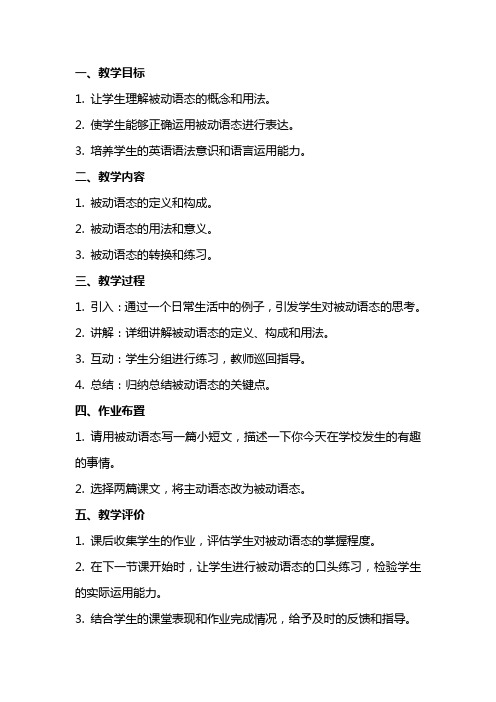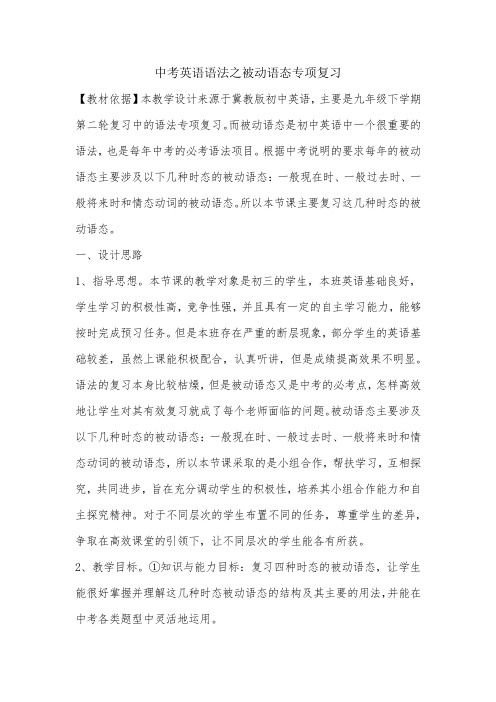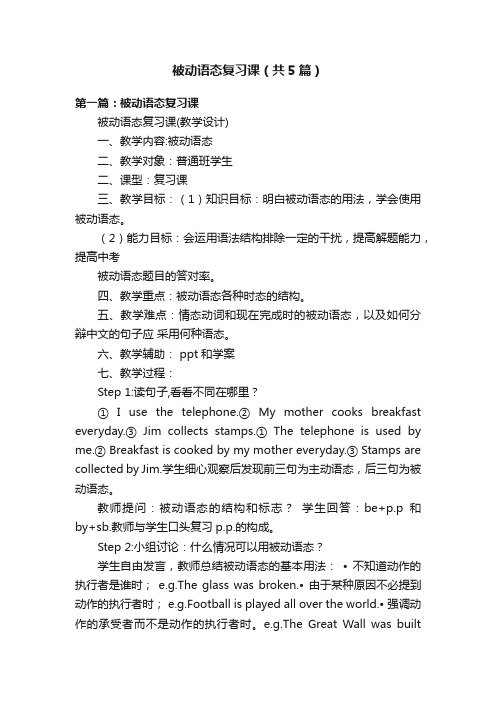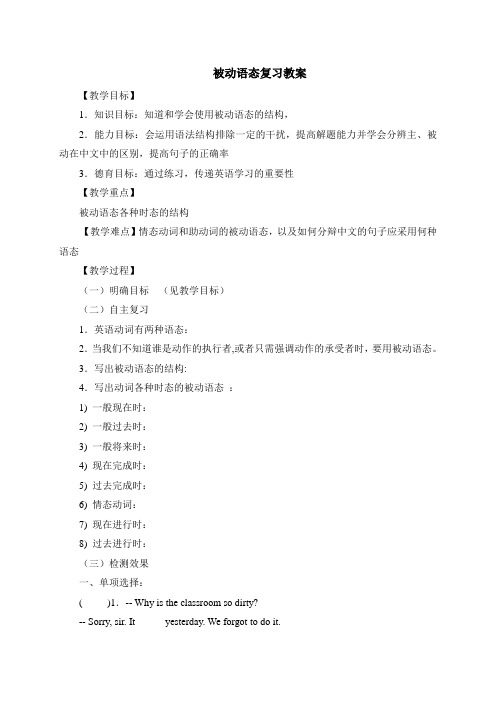被动语态专题复习教案
部编版初中被动语态英语教案范文总汇

1. 让学生理解被动语态的概念和用法。
2. 使学生能够正确运用被动语态进行表达。
3. 培养学生的英语语法意识和语言运用能力。
二、教学内容1. 被动语态的定义和构成。
2. 被动语态的用法和意义。
3. 被动语态的转换和练习。
三、教学过程1. 引入:通过一个日常生活中的例子,引发学生对被动语态的思考。
2. 讲解:详细讲解被动语态的定义、构成和用法。
3. 互动:学生分组进行练习,教师巡回指导。
4. 总结:归纳总结被动语态的关键点。
四、作业布置1. 请用被动语态写一篇小短文,描述一下你今天在学校发生的有趣的事情。
2. 选择两篇课文,将主动语态改为被动语态。
五、教学评价1. 课后收集学生的作业,评估学生对被动语态的掌握程度。
2. 在下一节课开始时,让学生进行被动语态的口头练习,检验学生的实际运用能力。
3. 结合学生的课堂表现和作业完成情况,给予及时的反馈和指导。
1. 采用任务型教学法,让学生在实际语境中运用被动语态。
2. 运用多媒体教学手段,如PPT、视频等,增加课堂趣味性。
3. 采用分组合作学习,提高学生的参与度和积极性。
七、教学资源1. PPT课件:包含被动语态的定义、用法和练习题。
2. 视频资料:关于被动语态的实例讲解。
3. 练习册:配套的被动语态练习题。
八、教学步骤1. 复习:回顾上节课所学的被动语态知识。
2. 讲解:通过实例讲解被动语态的运用。
3. 练习:学生分组进行被动语态的练习。
4. 拓展:引导学生运用被动语态进行创作。
九、课堂活动1. 小组讨论:学生分组讨论被动语态的用法。
2. 角色扮演:学生模拟真实场景,运用被动语态进行交流。
3. 写作展示:学生展示运用被动语态写作的成果。
十、课后反思1. 教师总结课堂教学效果,反思教学方法的适用性。
2. 学生反馈学习被动语态的难点和困惑,提出改进建议。
3. 针对学生的反馈,调整教学策略,为下一节课做好准备。
十一、教学拓展1. 对比主动语态和被动语态的用法和意义。
初中被动语态的教案

初中被动语态的教案一、教学目标1. 让学生理解被动语态的概念和用法。
2. 培养学生运用被动语态进行口语表达和写作的能力。
3. 提高学生对英语语态的敏感度和运用能力。
二、教学内容1. 被动语态的定义和构成。
2. 被动语态的常用时态和形式。
3. 被动语态的用法和注意事项。
三、教学方法1. 采用实例分析法,通过具体例句讲解被动语态的构成和用法。
2. 采用任务型教学法,让学生在实际语境中运用被动语态进行交流和表达。
3. 采用互动式教学法,鼓励学生积极参与,提高课堂氛围。
四、教学步骤1. 导入:通过一个简单的谜语引发学生对被动语态的兴趣,如:"Who is being seen?"。
2. 讲解:讲解被动语态的定义、构成和常用形式,如:am/is/are being + 过去分词;was/were being + 过去分词等。
3. 示例:通过具体例句展示被动语态的用法,如:"The cake was baked someone.","The window was broken him."。
4. 练习:让学生分组练习使用被动语态,如:互相描述对方正在做的事情。
5. 应用:设计一个情景剧,让学生在角色扮演中运用被动语态,如:警察询问目击者。
五、作业布置1. 让学生用被动语态写一篇小作文,描述一天的经历。
2. 找出课文中使用被动语态的句子,进行标注和理解。
3. 复习被动语态的知识点,为下一节课做准备。
教学评价:通过课堂参与、练习和作业的情况,评价学生对被动语态的理解和运用能力。
在下一节课开始时,可以让学生进行一个小测验,检验他们对被动语态的掌握程度。
六、教学扩展1. 对比主动语态和被动语态:分析两种语态在意义和用法上的异同,让学生更好地把握被动语态的特点。
2. 被动语态的特殊情况:讲解一些特殊的被动语态结构,如:"something is being done" 和"someone is being seen" 等。
中考被动语态专项复习课教案

一般将来时:will+ be+ vt.p.p.
现在完成时:have/has+ been+ vt.p.p.
课堂检测(一)
让学生判断下列句子是主动语态还是被动语态。
1.They play football on Sunday.
2. He took good care of his little brother yesterday.
2. Now people can use computers to help them.
Now computers _______ ______ ______ to help them.
3.I found the ticket on the floor.
______ ______ ______ ______ on the floor.
e.g. He gives me a flower everyday.
被动1 I am given a flower by him everyday.
被动2 A flower is given to me by him everyday.
通过几道练习题让学生熟练。
使学生对本节课的重点一目了然,清清楚楚。
现在完成时:have/has+ been+ vt.p.p.
THANKS
致力为企业和个人提供合同协议,策划案计划书,学习课件等等
打造全网一站式需求
欢迎您的下载,资料仅供参考
4.He will mend the bike tomorrow.
The bike ______ ______ _______ in two days.
(被动语态) 教学研复习教案

中考英语语法专题复习——被动语态(一)学科:英语课题:被动语态的复习教学目标:1.通过完成、核对并分析中考有关被动语态的典型试题以及相关阅读材料,学生能够归纳出中考被动语态的考查内容、考查形式和考查层次。
2.通过完成、核对、分析相关中考试题并结合对其考查内容、考查形式及层次的理解,学生能够归纳出在单项填空中被动语态试题的解题思路和得分对策,并能够正确理解阅读中被动语态的意义,在书面表达中能够正确运用。
3.通过对被动语态这项语法的学习,学生能够认识到复习词汇的重要性,从而重视常规的词汇复习,养成每日主动复习词汇的习惯。
教学内容:1.有关话题“职业”的20个词汇;2.有关被动语态的单项填空练习,两篇阅读材料和书面表达试题。
教学重点:1.学生了解被动语态在单项填空中的考查内容、考查形式及层次。
2.学生在阅读中能够正确理解带有被动语态句子的意义。
教学难点:书面表达中被动语态的正确运用。
教学手段:黑板、多媒体、粉笔、学案等。
教学步骤:一、常规认读单词(见附件一)1.根据PPT,学生逐一朗读单词并说出单词的中文意思。
2.全班齐读单词一遍。
二、导入1.教师通过对学生的提问,引出本课复习内容:T:同学们,你们知道在中考试题中,语法主要出现在哪种题型里呢?S:单选。
T: 那么单选都考哪些语法呢?S: 代词﹑介词﹑连词﹑形容词﹑副词﹑情态动词、时态、被动语态、宾语从句等等。
T: 好。
今天我们这节课主要复习被动语态。
(PPT呈现)下面请同学们看这六道单项填空题,并做出来。
三、复习被动语态(一)归纳被动语态在中考单项填空中的考查点及得分对策Step 1:学生在规定时间里完成6道单项填空练习题(见附件二)。
Step 2: 学生说出答案,并在教师引导下进行试题分析。
题1. Today Chinese ________ by more and more people around the world.(2006北京市中考)A. is spokenB. was spokenC. spokeD. speak解析:根据语境可知本题考查被动语态的基本构成和时态。
中考英语语法之被动语态专项复习 教案

中考英语语法之被动语态专项复习【教材依据】本教学设计来源于冀教版初中英语,主要是九年级下学期第二轮复习中的语法专项复习。
而被动语态是初中英语中一个很重要的语法,也是每年中考的必考语法项目。
根据中考说明的要求每年的被动语态主要涉及以下几种时态的被动语态:一般现在时、一般过去时、一般将来时和情态动词的被动语态。
所以本节课主要复习这几种时态的被动语态。
一、设计思路1、指导思想。
本节课的教学对象是初三的学生,本班英语基础良好,学生学习的积极性高,竞争性强,并且具有一定的自主学习能力,能够按时完成预习任务。
但是本班存在严重的断层现象,部分学生的英语基础较差,虽然上课能积极配合,认真听讲,但是成绩提高效果不明显。
语法的复习本身比较枯燥,但是被动语态又是中考的必考点,怎样高效地让学生对其有效复习就成了每个老师面临的问题。
被动语态主要涉及以下几种时态的被动语态:一般现在时、一般过去时、一般将来时和情态动词的被动语态,所以本节课采取的是小组合作,帮扶学习,互相探究,共同进步,旨在充分调动学生的积极性,培养其小组合作能力和自主探究精神。
对于不同层次的学生布置不同的任务,尊重学生的差异,争取在高效课堂的引领下,让不同层次的学生能各有所获。
2、教学目标。
①知识与能力目标:复习四种时态的被动语态,让学生能很好掌握并理解这几种时态被动语态的结构及其主要的用法,并能在中考各类题型中灵活地运用。
②方法与途径:通过让学生预习所复习的语法,并在课堂上小组合作用思维导图展示成果的方式有效复习四种时态的被动语态。
尊重学生的差异,让各类学生都能学有所得,学有所获。
③情感与评价目标:在小组合作的过程中,注意观察并培养学生用思维导图的方式与学过的话题结合的能力,培养其归纳、合作意识,提高学习英语的兴趣。
④教学手段应用:运用ppt及音乐二、教学准备①提前布置预习任务,学生提前查阅相关的教材找出被动语态的相关知识以及需要注意的问题。
②有关被动语态的电影对话,音乐及ppt三、教学过程(Teaching Procedure)Step 1 Warming-up1. Listen to the music before class and Ss try to find the passive voice sentences in it.2. Look at the interesting dialogues in the movie and also find out the passive voice sentences.Step 2 Check their preview workT checks their preview work by asking some simple questions.Step 3 Group WorkFour of them are in groups and they try to design a mind map on passive voice of four different tenses. At the same time, they try their best to relatethe passive voice to he topic and summarize the correct usage of them. Step 4 Show Time①T will ask four groups to show their achievement in front of the whole class.②Ss will have a quick discussion on their work and choose the best one.③T will make a quick summary and supplement on their work and correct their mistakes.Step 5 Special using of the passive voiceSs still are in groups to discuss the special using of the passive voice and finish some relative exercise.Step 6 Challenge the high school entry examination exercise from 2010-2016.Step 7 Make SummaryT makes a summary of the important forms of “be done”in different tenses.Step 8 Write a CompositionWrite a short Composition on Great Change of Our Village and try to use passive voice.Step 9 HomeworkFinish the exercise on workbook.四、教学反思义务教育英语课程标准要求教师要“以人为本”,最大化地发挥学生的主动性,将主动权交给学生,努力培养学生的自主学习能力,提高课堂效率。
被动语态复习课(共5篇)

被动语态复习课(共5篇)第一篇:被动语态复习课被动语态复习课(教学设计)一、教学内容:被动语态二、教学对象:普通班学生二、课型:复习课三、教学目标:(1)知识目标:明白被动语态的用法,学会使用被动语态。
(2)能力目标:会运用语法结构排除一定的干扰,提高解题能力,提高中考被动语态题目的答对率。
四、教学重点:被动语态各种时态的结构。
五、教学难点:情态动词和现在完成时的被动语态,以及如何分辩中文的句子应采用何种语态。
六、教学辅助: ppt和学案七、教学过程:Step 1:读句子,看看不同在哪里?① I use the telephone.② My mother cooks breakfast everyday.③ Jim collects stamps.① The telephone is used by me.② Breakfast is cooked by my mother everyday.③ Stamps are collected by Jim.学生细心观察后发现前三句为主动语态,后三句为被动语态。
教师提问:被动语态的结构和标志?学生回答:be+p.p和by+sb.教师与学生口头复习p.p.的构成。
Step 2:小组讨论:什么情况可以用被动语态?学生自由发言,教师总结被动语态的基本用法:• 不知道动作的执行者是谁时;e.g.The glass was broken.• 由于某种原因不必提到动作的执行者时;e.g.Football is played all over the world.• 强调动作的承受者而不是动作的执行者时。
e.g.The Great Wall was builtlong long ago.Step 3:举例子,分析题目(时态,单复数),发现规律,使用学案作总结。
1.一般现在时:They make shoes in that factory.→Shoes are made(by them)in that factory.总结: 一般现在时被动语态结构为am/is /are +p.p.完成《学案》选择题1、2 2.一般过去时They bought ten computers last term.→Ten computers were bought(by them)last term.总结: 一般过去时被动语态结构为was /were +p.p.完成《学案》选择题3、43.一般将来时(含will)They will finish the work tomorrow.→The work will be finished(by them)tomorrow.总结: 一般将来时被动语态结构为will+be +p.p.完成《学案》选择题5、6 4.现在完成时:(have/has+p.p.)Danny has finished the project.→The project has been finished(by Danny).总结: 现在完成时被动语态结构为have/has+been +p.p.完成《学案》选择题7、8 5.含情态动词(must, should, may, can, could, might…)Amy can make a cake .→A cake can be made(by Amy).总结: 含情态动词被动语态结构为情态动词+be +p.p.完成《学案》选择题9、10 Step 4:教师提出:take place, happen, belong to无被动语态;商场开业(open)无须用被动语态。
被动语态复习教案

被动语态复习教案【教学目标】1.知识目标:知道和学会使用被动语态的结构,2.能力目标:会运用语法结构排除一定的干扰,提高解题能力并学会分辨主、被动在中文中的区别,提高句子的正确率3.德育目标:通过练习,传递英语学习的重要性【教学重点】被动语态各种时态的结构【教学难点】情态动词和助动词的被动语态,以及如何分辩中文的句子应采用何种语态【教学过程】(一)明确目标(见教学目标)(二)自主复习1.英语动词有两种语态:2.当我们不知道谁是动作的执行者,或者只需强调动作的承受者时,要用被动语态。
3.写出被动语态的结构: ______________4.写出动词各种时态的被动语态:1) 一般现在时:__________________________2) 一般过去时:_____________________________________3) 一般将来时:_____________________________________4) 现在完成时:_____________________________________5) 过去完成时:_____________________________________6) 情态动词:_____________________________________7) 现在进行时:_____________________________________8) 过去进行时:_____________________________________(三)检测效果一、单项选择:( )1.-- Why is the classroom so dirty?-- Sorry, sir. It _____ yesterday. We forgot to do it.A. didn’t cleanB. isn’t cleanedC. wasn’t cleaned( )2.--Have you heard of the movie 2012?-- Yes. It _____ in Hongse Theatre last winter.A. showsB. was shownC. is shown( )3.The stars _____ in the daytime.A. can be seenB. can seeC. can’t be seenD. can’t see( )4.--Have all the students known that our class will visit the factory?-- Yes, every student _____ about it.A. have toldB. have been toldC. has toldD. has been told( )5.To make our city more beautiful, rubbish _____ into the river.A. needn’t be thrownB. mustn’t be thrownC. can’t throw二、用括号内所给动词的适当形式填空。
被动语态复习专项 优秀教学设计

被动语态复习专项
Step7: 1.Divide Ss into two groups. Red Group and Blue Group
Competition 2.Let students choose the questions and give the
answers.
设计意图:
1.通过小组竞赛增加学生的兴趣。
2将近三年中考真题和沙区模考题作为小组竞赛题库、降低
学生对中考的恐惧。
3本环节将被动语态的特殊用法进行复习,并适当给出扩充,
突破本节课难点。
Step7: T : What kind of questions can you see about passive voice?
Ss:选择题,句型转换,词汇题,翻译题。
充形填空。
设计意图:
通过帮动学生归纳被动语态在中考中的题型,给学生不同题
型的做题技巧指导。
Homework Do exercise about passive voice.
设计意图:
本节课学生已接触到马鲁木齐市,沙区模考中的真题,所以
在家庭作业的设置上,选用了其他省份的真题,共20题。
板书设计 Top
Stop1 Stop2 Stop3
教学反思
本节课学生统够积极参与,覆盖率高,学生能够自主学习,
互相配合。
通过四个活动的学习,达到本节课的教学目标,
在最后竞赛活动中,对难点进行突破。
但我的教学设计仍然
有许多不足之处,时间把控不好,最后由于时间比较紧,有
些合促、对学生的评价机制还不够,以后上课应多一些
评价性语言,多鼓励学生。
- 1、下载文档前请自行甄别文档内容的完整性,平台不提供额外的编辑、内容补充、找答案等附加服务。
- 2、"仅部分预览"的文档,不可在线预览部分如存在完整性等问题,可反馈申请退款(可完整预览的文档不适用该条件!)。
- 3、如文档侵犯您的权益,请联系客服反馈,我们会尽快为您处理(人工客服工作时间:9:00-18:30)。
被动语态
一、语态概述英语的语态是通过动词形式的变化表现出来的。
英语中有两种语态:主动语态和被动语态。
主动语态表示主语是动作的执行者。
例如:Many people speak Chinese.
谓语:speak的动作是由主语many people来执行的。
被动语态表示主语是动作的承受者,即行为动作的对象。
例如:Chinese is spoken by many people.
主语English是动词speak的承受者。
一、被动语态的构成
被动语态由"助动词be+及物动词的过去分词"构成。
人称、数和时态的变化是通过be的变化表现出来的。
被动语态的各种形式:
1) 一般现在时:am/is/are +done
eg:I'm asked to take care of myself.
eg:Football is played all over the world.
2)现在完成时:has /have been done
eg:This book has been translated into many foreign languages.
eg:The prices of many goods have been cut again .
3)现在进行时:am/is /are being done
eg:A road is being built around the mountain.
eg:Many new houses are being built in this city.
4)一般过去时:was/were done e
eg1:This house was built in 1958.
eg2:His leg was broken in an accident..
5)过去完成时:had been done
eg1:A new school had been set up by the end of last year.
eg2:When the anthem had been played the conference began.
6) 过去进行时:was/were being done
eg1:meeting was being held when I was there.
eg2:We were being trained this time last year.
7) 一般将来时:shall/will be done
eg1:More factories will be built in our city.
eg2:He will be taken to hospital tomorrow.
8) 将来完成时:shall/will have been done
eg1:The project will have been completed before July.
eg2:Your clothes shall have been made for you soon.
三、被动语态的用法
(1)不知道或没有必要说明动作的执行者是谁。
例如:Some new computers were stolen last night.一些新电脑在昨晚被盗了。
(不知道电脑是谁偷的)
This bridge was built in 1981.这座桥建于1981年。
(2)强调动作的承受者,而不强调动作的执行者。
例如:The glass was broken by Mike.玻璃杯是迈克打破的。
This book was written by him.这本书是他写的。
Your homework must be finished on time.你们的家庭作业必须及时完成。
四、主动语态变被动语态的方法
(1)把主动语态的宾语变为被动语态的主语。
(2)把谓语变成被动结构(be+过去分词) (根据被动语态句子里的主语的人称和数,以及原来主动语态句子中动词的时态来决定be的形式)。
(3)把主动语态中的主语放在介词by之后作宾语,将主格改为宾格。
例如:All the people laughed at him.
He was laughed at by all people.
They make the bikes in the factory.
The bikes are made by them in the factory.
He cut down a tree.
A tree was cut down by him. :
练习:把下列句子变成被动语态。
1.People speak English in many countries.
2.People plant trees in spring.
3. We built this bridge last year.
4.Xiao Liu has invited you to a lunch party.
5.They are repairing the car in the garage.
6.They won't hold the meeting until next Friday.
7.Has anybody fed the birds?
8.People will never forget the accident.
9.You may write this letter in pencil.
10 The tiger in the zoo frightened the little girl.。
